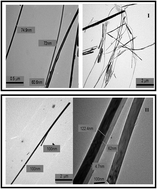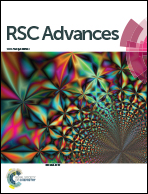Polyaniline and modified titanate nanowires layer-by-layer plastic electrode for flexible electronic device applications†
Abstract
Flexible transparent conductive electrodes represent the next generation electronics and are considered a vital part of the renewable energy technology. This article describes fabrication of a plastic ITO-free conductive electrode based on polyaniline/layered titanate nanocomposites using a layer-by-layer technique. Titanate nanowires (T-NWs) were first synthesized via a hydrothermal method in strong alkaline medium. The obtained NWs had length more than one micrometer and width of 100–120 nm. Modification of layered titanate using cetyltrimethyl ammonium bromide (CTAB), as cationic surfactant, was carried out through an ion exchange mechanism. T/CTAB-NWs were characterized using FTIR, XRD and the morphology was studied by TEM. Nanocomposites of polyaniline (PANI) and T/CTAB-NWs were prepared and well characterized using FT-IR, UV, XRD and TEM. The value of electrical conductivity of the prepared nanocomposite was found to be over two folds higher than that of pure PANI. Assembly of a flexible conductive electrode was prepared using multilayers of T/CTAB-NWs and PANI doped with camphor sulphonic acid (CSA). The transparency and photoelectrochemical properties of layer-by-layer (LBL) film of PANI–CSA and T/CTAB-NWs were investigated. The results confirmed the utility of the fabricated ITO-free conductive assembly as a photoelectrode for organic photovoltaic cells and flexible electronic devices.



 Please wait while we load your content...
Please wait while we load your content...